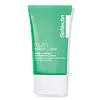SVR Cicapeel Sebiaclear Targeted Active Gel Versus StriVectin Multi-Action Clear: Acne Clearing Treatment Lotion
What's inside
What's inside
 Key Ingredients
Key Ingredients

 Benefits
Benefits

 Concerns
Concerns

 Ingredients Side-by-side
Ingredients Side-by-side

Water
Skin ConditioningGluconolactone
Skin ConditioningAlcohol
AntimicrobialGlycerin
HumectantSodium Hydroxide
BufferingHydroxyethylcellulose
Emulsion StabilisingSalicylic Acid
MaskingSarcosine
Skin ConditioningButylene Glycol
HumectantDenatonium Benzoate
MaskingPEG-60 Hydrogenated Castor Oil
EmulsifyingPEG-8 Dimethicone
EmulsifyingPentylene Glycol
Skin ConditioningT-Butyl Alcohol
PerfumingXanthan Gum
EmulsifyingParfum
MaskingSalicylic Acid 2%
MaskingWater
Skin ConditioningPropanediol
SolventAlcohol Denat.
AntimicrobialCaprylyl/Capryl Glucoside
CleansingAcetyl Glucosamine
Skin ConditioningDimethyl Isosorbide
SolventEthoxydiglycol
HumectantSuccinic Acid
BufferingButylene Glycol
HumectantSodium Hydroxide
BufferingAllantoin
Skin ConditioningParfum
MaskingSodium Benzoate
MaskingPotassium Sorbate
PreservativeMyristyl Nicotinate
Skin ConditioningTranexamic Acid
AstringentPhytic Acid
Xylitol
HumectantCaprylic Acid
CleansingSodium Carbonate
BufferingSodium Chloride
MaskingT-Butyl Alcohol
PerfumingPolyglutamic Acid
Skin ConditioningDextran
Tripeptide-1
Skin ConditioningDenatonium Benzoate
MaskingLinalool
PerfumingGeraniol
PerfumingBenzyl Salicylate
PerfumingSalicylic Acid 2%, Water, Propanediol, Alcohol Denat., Caprylyl/Capryl Glucoside, Acetyl Glucosamine, Dimethyl Isosorbide, Ethoxydiglycol, Succinic Acid, Butylene Glycol, Sodium Hydroxide, Allantoin, Parfum, Sodium Benzoate, Potassium Sorbate, Myristyl Nicotinate, Tranexamic Acid, Phytic Acid, Xylitol, Caprylic Acid, Sodium Carbonate, Sodium Chloride, T-Butyl Alcohol, Polyglutamic Acid, Dextran, Tripeptide-1, Denatonium Benzoate, Linalool, Geraniol, Benzyl Salicylate
Ingredients Explained
These ingredients are found in both products.
Ingredients higher up in an ingredient list are typically present in a larger amount.
Butylene Glycol (or BG) is used within cosmetic products for a few different reasons:
Overall, Butylene Glycol is a safe and well-rounded ingredient that works well with other ingredients.
Though this ingredient works well with most skin types, some people with sensitive skin may experience a reaction such as allergic rashes, closed comedones, or itchiness.
Learn more about Butylene GlycolDenatonium Benzoate is a denaturant and masking ingredient.
It is commonly used to denature alcohols, such as SD Alcohol 40.
Fun fact: This ingredient is the most bitter known compound. The bitter flavor is often used to deter consumption.
Learn more about Denatonium BenzoateParfum is a catch-all term for an ingredient or more that is used to give a scent to products.
Also called "fragrance", this ingredient can be a blend of hundreds of chemicals or plant oils. This means every product with "fragrance" or "parfum" in the ingredients list is a different mixture.
For instance, Habanolide is a proprietary trade name for a specific aroma chemical. When used as a fragrance ingredient in cosmetics, most aroma chemicals fall under the broad labeling category of “FRAGRANCE” or “PARFUM” according to EU and US regulations.
The term 'parfum' or 'fragrance' is not regulated in many countries. In many cases, it is up to the brand to define this term.
For instance, many brands choose to label themselves as "fragrance-free" because they are not using synthetic fragrances. However, their products may still contain ingredients such as essential oils that are considered a fragrance by INCI standards.
One example is Calendula flower extract. Calendula is an essential oil that still imparts a scent or 'fragrance'.
Depending on the blend, the ingredients in the mixture can cause allergies and sensitivities on the skin. Some ingredients that are known EU allergens include linalool and citronellol.
Parfum can also be used to mask or cover an unpleasant scent.
The bottom line is: not all fragrances/parfum/ingredients are created equally. If you are worried about fragrances, we recommend taking a closer look at an ingredient. And of course, we always recommend speaking with a professional.
Learn more about ParfumSalicylic Acid (also known as beta hydroxy acid or BHA) is a well-known ingredient for treating skin that struggles with acne and clogged pores. It exfoliates both the skin's surface and deep within the pores to help clear out buildup, control oil, and reduce inflammation.
Unlike AHAs (alpha hydroxy acids), salicylic acid is oil-soluble. This allows it to penetrate into pores which makes it especially effective for treating blackheads and preventing future breakouts.
Salicylic acid is also known for its soothing properties. It has a similar structure to aspirin and can calm inflamed or irritated skin, making it a good option for acne-prone skin that is also sensitive.
Concentrations of 0.5-2% are recognized by the U.S. FDA as an over-the-counter topical acne product.
It can cause irritation and/or dryness if one's skin already has a compromised moisture barrier, so it's best to focus on repairing that before introducing this ingredient into your routine.
While salicylic acid does not increase sun sensitivity, it’s still important to wear sunscreen daily to protect your skin.
If you are looking for the ingredient called BHA or Butylated Hydroxyanisole, click here.
Learn more about Salicylic AcidSodium Hydroxide is also known as lye or caustic soda. It is used to adjust the pH of products; many ingredients require a specific pH to be effective.
In small amounts, sodium hydroxide is considered safe to use. However, large amounts may cause chemical burns due to its high alkaline.
Your skin has a natural pH and acid mantle. This acid mantle helps prevent harmful bacteria from breaking through. The acid mantle also helps keep your skin hydrated.
"Alkaline" refers to a high pH level. A low pH level would be considered acidic.
Learn more about Sodium HydroxideT-Butyl Alcohol it is most commonly used as a solvent.
At room temperature, T-Butyl Alcohol melts and has a similar smell to camphor.
This ingredient is derived from isobutane. It is the simplest form of a tertiary alcohol. Due to its chemical structure, it is more resistant to oxidation.
Some sources online claim T-Butyl Alcohol is a fatty alcohol. However, it is not considered one due to its chemical structure.
Learn more about T-Butyl AlcoholWater. It's the most common cosmetic ingredient of all. You'll usually see it at the top of ingredient lists, meaning that it makes up the largest part of the product.
So why is it so popular? Water most often acts as a solvent - this means that it helps dissolve other ingredients into the formulation.
You'll also recognize water as that liquid we all need to stay alive. If you see this, drink a glass of water. Stay hydrated!
Learn more about Water